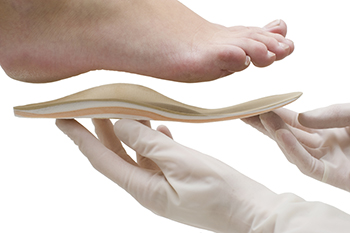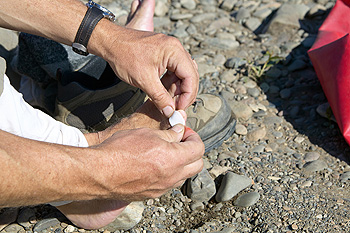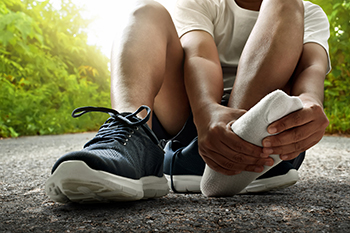
As a child grows and navigates their way through their youth, they may experience any number of foot problems. For example, your child may complain to you about having foot pain as a result of having flat feet. Consequently, your child might have sunken arches in their feet and turn their feet inward when walking. One important way in which you might be able to help improve the condition of your child’s feet is with orthotics. These custom-made shoe inserts can be made to exactly fit your child’s specific foot, and are made to help correct their gait. Namely, orthotics for children with flat feet are designed to have arch support cushions that encourage their feet not to collapse into the ground when walking. Additionally, orthotics for children with flat feet also have heel cushions that are intended to strengthen the ankles. These shoe inserts can be utilized in many different kinds of spacious footwear for children. Orthotics are not just for children – they have been effective in correcting the gaits of individuals of all ages as well. When it comes to protecting the health of your child’s feet, it is best not to take chances and to be proactive in preventing injuries. It is highly suggested to see a podiatrist for more information about orthotics.
If you are having discomfort in your feet and would like to try orthotics, contact Dr. Lubrina Bryant from District Podiatry, PLLC. Our doctor can provide the care you need to keep you pain-free and on your feet.
What Are Orthotics?
Orthotics are inserts you can place into your shoes to help with a variety of foot problems such as flat feet or foot pain. Orthotics provide relief and comfort for minor foot and heel pain but can’t correct serious biomechanical problems in your feet.
Over-the-Counter Inserts
Orthotics come in a wide variety of over-the-counter inserts that are used to treat foot pain, heel pain, and minor problems. For example, arch supports can be inserted into your shoes to help correct overarched or flat feet, while gel insoles are often used because they provide comfort and relief from foot and heel pain by alleviating pressure.
Prescription Orthotics
If over-the-counter inserts don’t work for you or if you have a more severe foot concern, it is possible to have your podiatrist prescribe custom orthotics. These high-quality inserts are designed to treat problems such as abnormal motion, plantar fasciitis, and severe forms of heel pain. They can even be used to help patients suffering from diabetes by treating foot ulcers and painful calluses and are usually molded to your feet individually, which allows them to provide full support and comfort.
If you are experiencing minor to severe foot or heel pain, it’s recommended to speak with your podiatrist about the possibilities of using orthotics. A podiatrist can determine which type of orthotic is right for you and allow you to take the first steps towards being pain-free.
If you have any questions please contact our office located in Washington, D.C . We offer the newest diagnostic and treatment technologies for all your foot and ankle needs.

A blister that forms on the skin of the feet is a common response to excess friction from shoes, or from an injury. It is defined as the body’s natural defense mechanism to protect damaged skin. A small area that is filled with liquid can form over the raw skin, and this protects the skin as new skin develops. It is important to cover the blister, and this can help to avoid premature popping. A loose elastic bandage generally works well, or some people use a padded bandage. When new skin has grown, the blister is no longer needed, and will gradually drain. Common reasons for patients to develop blisters can include wearing shoes that do not fit correctly, having an allergic reaction, or possibly from severe sunburn. Additionally, blisters may form from wearing damp socks, and it can help to wear socks that can absorb moisture. If a chemical spills on the feet, the result may be a blister forming. If you have blisters on your feet that are recurring, or if a blister has become infected, it is suggested that you consult with a podiatrist who can help you with treatment options.
Blisters may appear as a single bubble or in a cluster. They can cause a lot of pain and may be filled with pus, blood, or watery serum. If your feet are hurting, contact Dr. Lubrina Bryant of District Podiatry, PLLC. Our doctor can provide the care you need to keep you pain-free and on your feet.
Foot Blisters
Foot blisters are often the result of friction. This happens due to the constant rubbing from shoes, which can lead to pain.
What Are Foot Blisters?
A foot blister is a small fluid-filled pocket that forms on the upper-most layer of the skin. Blisters are filled with clear fluid and can lead to blood drainage or pus if the area becomes infected.
Symptoms
(Blister symptoms may vary depending on what is causing them)
Prevention & Treatment
In order to prevent blisters, you should be sure to wear comfortable shoes with socks that cushion your feet and absorb sweat. Breaking a blister open may increase your chances of developing an infection. However, if your blister breaks, you should wash the area with soap and water immediately and then apply a bandage to the affected area. If your blisters cause severe pain it is important that you call your podiatrist right away.
If you have any questions, please feel free to contact our office located in Washington, D.C . We offer the newest diagnostic and treatment technologies for all your foot care needs.

Protecting and caring for your heels is a critical component of maintaining proper foot health. However, a heel spur is a troublesome condition that can negatively impact your heels’ vigor. Heel spurs, also referred to as calcaneal spurs, are essentially bony bulges that form on the heel bone either on the back of the heel or under the sole of the foot. Heel spurs usually develop in response to plantar fasciitis and especially when stress is exerted on the plantar fascia for an extended period of time. Individuals who are middle-aged or overweight may be at an increased risk of developing this unfortunate foot affliction. Although some cases of heel spurs are asymptomatic and do not produce pain, many individuals with heel spurs can experience heel pain when beginning to walk after a period of rest. If you have a case of heel spurs, a podiatrist can help you address the condition. If your heel spurs are related to plantar fasciitis, they might be treated with orthotics such as night splints, heel inserts, or special footwear. When it comes to caring for your heels, it is highly suggested you consult with a podiatrist instead of taking chances.
Heel spurs can be incredibly painful and sometimes may make you unable to participate in physical activities. To get medical care for your heel spurs, contact Dr. Lubrina Bryant from District Podiatry, PLLC. Our doctor will do everything possible to treat your condition.
Heels Spurs
Heel spurs are formed by calcium deposits on the back of the foot where the heel is. This can also be caused by small fragments of bone breaking off one section of the foot, attaching onto the back of the foot. Heel spurs can also be bone growth on the back of the foot and may grow in the direction of the arch of the foot.
Older individuals usually suffer from heel spurs and pain sometimes intensifies with age. One of the main condition's spurs are related to is plantar fasciitis.
Pain
The pain associated with spurs is often because of weight placed on the feet. When someone is walking, their entire weight is concentrated on the feet. Bone spurs then have the tendency to affect other bones and tissues around the foot. As the pain continues, the feet will become tender and sensitive over time.
Treatments
There are many ways to treat heel spurs. If one is suffering from heel spurs in conjunction with pain, there are several methods for healing. Medication, surgery, and herbal care are some options.
If you have any questions feel free to contact our office located in Washington, D.C . We offer the latest in diagnostic and treatment technology to meet your needs.

Pain in one’s toes can interfere with a running routine. Toe injuries while running can heal in a short amount of time with care and rest, but a more serious problem with a toe may derail a runner’s routine and set them back for longer than comfortable. Common toe problems in runners range from mild blisters to more serious hammertoes and stress fractures. A blister is caused by friction between the skin and shoes or socks. The outer layer of the skin separates from the inner layer and fills with lymph fluid. These are most common when a runner wears new shoes for the first time or increases their mileage. A hammertoe causes one or more of the smaller toes to bend upward. A corn or callus can develop on top of such a toe causing it to rub against shoes and the toe joint(s) can become swollen and painful. Stress fractures are common in teen athletes and are a result of overdoing runs. If a toenail becomes painful and begins to blacken, it might be runner’s toe. This is when the nail is under pressure because a shoe is too tight, or the toe is impacted repeatedly while running. Pressure causes friction between the nail and surrounding tissue. Fluid accumulates and blood capillaries break, causing the toenail to change color and pain to come on. The blackened toenail will eventually fall off, but this could take months. If you are a runner and you have toe pain, consult with a podiatrist who can diagnose the problem and determine how to best treat it.
Ankle and foot injuries are common among athletes and in many sports. They can be caused by several problems and may be potentially serious. If you are feeling pain or think you were injured in a sporting event or when exercising, consult with Dr. Lubrina Bryant from District Podiatry, PLLC. Our doctor will assess your condition and provide you with quality foot and ankle treatment.
Common Injuries
The most common injuries that occur in sporting activities include:
Symptoms
Symptoms vary depending upon the injury and in some cases, there may be no symptoms at all. However, in most cases, some form of symptom is experienced. Pain, aching, burning, bruising, tenderness, tightness or stiffness, sensation loss, difficulty moving, and swelling are the most common symptoms.
Treatment
Just as symptoms vary depending upon the injury, so do treatment options. A common treatment method is known as the RICE method. This method involves rest, applying ice, compression and elevating the afflicted foot or ankle. If the injury appears to be more serious, surgery might be required, such as arthroscopic or reconstructive surgery. Lastly, rehabilitation or therapy might be needed to gain full functionality in the afflicted area. Any discomfort experienced by an athlete must be evaluated by a licensed, reputable medical professional.
If you have any questions, please feel free to contact our office located in Washington, D.C . We offer the newest diagnostic and treatment technologies for all your foot care needs.